Presentation and target species are the two biggest factors to
consider when making a decision between spinning and casting tackle. If
you're thinking of tossing big baits to heavy hitters, it's probably
time to look into a casting setup.
But when, exactly, is a lure considered too heavy for spinning tackle? What species require the extra line capacity and cranking power of a casting reel? And with the huge selection of casting reels available, how do you know which reel is the best value for the money?
This buyer's guide will explain what casting tackle does best, as well as what's better left to spinning gear. It will also explain how to determine which reel is the best for the money you're able to invest.
First of all, what is a baitcasting reel? Baitcaster, baitcasting reel, and casting reels refers to reels that
1. Have a revolving spool
2. Sits on top of a rod
3. Is used to cast lures with precision to a target
Conventional reels also have a revolving spool and look nearly identical to round casting reels, they're designed for trolling and fishing vertically for large species. Conventional reels are not designed for making numerous casts throughout a day.
Most modern casting reels come in left-handed and right-handed configurations. A right-handed configuration means that, after you've made your cast, the reel is placed in your left hand and the handle is cranked using your right hand. This configuration is the most common, largely because left-handed models were extremely hard to find until recent years. Unlike spinning reels, the handle of a casting reel cannot be removed and re-attached to either side of the reel to match the retrieve preference of different anglers.
If you come from a spinning background, you might consider getting a reel with a left-handed configuration. Since left-handed reels allow you to crank the handle with your left hand, as you do with spinning tackle, it would probably be the most familiar to you. It would also eliminate the need to switch hands after you cast.
When Casting Tackle Works Best
As previously mentioned, casting tackle is often required when heavier baits are used. "What's considered a heavy bait," you ask? As a general rule, use spinning gear for lures 1/4-ounce or less. For any lure heavier than a 1/4-ounce, use casting tackle.
Heavier baits generally require an increase in line strength. Most anglers typically prefer spinning gear when using 8-pound test line (about .012" diameter) or less. If you're presentation requires 10-pound test line or more, casting gear is the way to go.
As you all know, there are two different types of baitcasting reels, that is round baitcasting reels and low profile baitcaster reels. Round reels typically have larger spools that are able to hold more line, while low-profile reels are more ergonomic, allowing anglers to palm the reel during the retrieve. In recent years, low-profile reels have become the most popular style among anglers.
Because round reels have more line capacity than low-profile reels, round reels are suggested for larger fish and species known to make long runs.
Gear Ratio
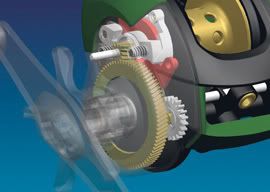
Every reel has a gear ratio, which is often used to describe the "speed" of the reel. For instance, a reel with a 5.4:1 gear ratio is considered a standard retrieve. A 6.4:1 ratio is considered high speed, and a 7.1:1 ratio is considered super high speed. What these numbers actually describe is the number of times the spool turns with one turn of the reel handle. For example, a 6.4:1 ratio means the spool of the reel will turn 6.4 times with a single turn of the handle. Line recovery (the amount of line recovered with each turn of the handle) is related to gear ratio, but it's also affected by the size of the reel's spool.
Some gear ratios are better suited to certain fishing styles than others. For instance, super-high-speed reels are used by run-and-gun spinnerbait enthusiasts because these reels allow anglers to cover a lot of water quickly.
High speeds aren't necessarily about making the lure move through the water faster, though,because you need to fish lures at the speed they work best. What high speed reels actually do is -- once you've pulled your lure through the strike zone -- they allow you to get the lure back to the boat quickly to make another cast.
Braking Systems
Casting reels are equipped with braking systems that help manage the speed of the rotation of the spool during a cast in order to minimize backlashes. If you've never had one, a backlash (also dubbed "bird's nest" or "professional overrun") is the tangled, knotted mess of line that results when your spool continues to spin after your lure has stopped moving forward. Backlashes are the bane of angler's everywhere and probably the number one deterrent to those hesitant to add a casting combo to their gear arsenal.
The spool tension knob is the main coarse adjustment on your casting reel. This is the first thing you should adjust, and applying the correct amount of tension to the spool is your first step toward combating backlash. The spool tension knob should be set tight enough that, when you disengage the spool, the lure should fall slowly to the ground. When it hits the ground, the spool should not turn more than once. A spool tension knob is found on every casting reel.
Magnetic brakes and centrifugal brakes are the two most common braking systems. Centrifugal braking systems are friction based and typically have pins that adjust to apply more or less friction to the spool. When making adjustments, push the pins inward to take them out of play and push them out to engage the brakes. When adjusting pins, the rule of thumb is to remove brakes opposite of one another. So, if you're removing two of the brakes in a six-pin system, you would push two pins in that are directly across from one another rather than two that are directly beside each other.
Magnetic braking systems are harder to explain than centrifugal systems as they rely on a spool made of aluminum (a non-magnetic metal) reacting to a set of magnets. "How does a non-magnetic metal react to magnets," you ask? Well, when the aluminum spool is rotating, the closeness of the aluminum to the magnets creates what's called an "eddy current," and this eddy current creates the braking effect on the spool. Spool speed affects current strength -- the faster the rotation of the spool, the stronger the eddy current -- as does the distance of the magnets to the spool, which is why magnetic systems are adjustable. What we anglers need to know, though, is that you move the magnets closer to the spool to increase spool tension and move them farther from the spool to decrease spool tension.
Some braking systems, such as the Inertial Transfer Braking (ITB) system and Dual Braking System, make use of both friction and magnetic elements. What's especially nice about the ITB and Dual Braking Systems, though, is that they're both externally adjustable -- no popping off side plates to adjust pins or remove magnets while on the water.
On which system is better, actually it's a matter of personal preference. If you're going from a heavy lure to a lighter one, you have to make some adjustments. When you're fishing in windy conditions, you'll also need to adjust because the wind will slow the lure faster than the spool will slow from the initial cast. Making these on-the-water adjustments is where externally adjustable systems really come in handy. But for the most part, braking systems are fine tuning things. The heart of the matter is still practicing with your reel and learning to address the spool with your thumb.
Components & Materials
Once you've narrowed your options down to a few reels, the best way to determine which reel is the best choice for the amount of money you're ready to invest is by comparing the components of each reel. When comparing components, you want to look at the method of construction as well as the materials used for construction. Below we'll discuss the key casting reel components, material options and construction methods.
Frame
Casting reel frames are usually made of either graphite or aluminum. Graphite is lightweight and tends to be less expensive than aluminum. The drawback, however, is that graphite flexes under pressure. Aluminum frames, which tend to be found on more expensive casting reels, are more rigid. A rigid frame ensures all moving parts remain properly aligned. Top-of-the-line reels have one-piece aluminum frames.
Gears
Gears are extremely important -- probably the most important component to consider. The difference between a reel with good gears and one with inferior gears is usually noticeable immediately just by turning the handle. When you pick up a nice reel and turn the handle, you'll feel the smoothness and appreciate how easy it is to turn the handle.
Most main gears are brass with a steel pinion gear. Duralumin, which is extremely lightweight and strong, is used for gearing on the very finest reels. If the difference between a reel with good gears and another with mediocre gears is minimal, spend it if you can -- you won't regret it.
Ball Bearings
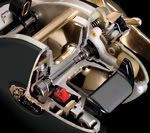
Many anglers believe that the more bearings a reel has, the better it is. That's not actually the case, though, as all bearings are not created equal. Shielded, double-shielded and sealed bearings are the highest quality and are usually made in Germany or Japan. The lowest-grade bearings are made of lower quality steel. Bearings made from low-quality steel will rust and won't wear as well as high-quality bearings.
If you get a 10-bearing reel for $150, you can almost bet it's packed with cheap bearings. So, if you're presented with a choice between a reel with 3 good bearings and a reel with 10 cheap bearings (assuming they're the same price and all other things are equal), opt for the reel with fewer, yet higher quality bearings.
Spools
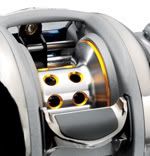
Most all reels have aluminum spools. Where they differ, though, is in the construction process. The least expensive spools are die-cast. Spools machined from stock are more expensive, and top-of-the-line spools are forged.
Machined spools scratch fairly easy, while a forged spool is very hard to scratch. Forged spools are harder, denser and more rigid so that they don't flex under pressure. Drilled spools (those with holes through them) are lightweight, making them easier to start and stop spinning. Non-drilled spools are heavier and require more force to get going; once they start spinning, non-drilled spools take a little more pressure from the thumb to stop.
Drag systems
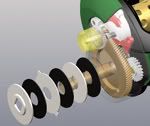
In general, drag systems are more critical for saltwater species and long-running fish than they are for bass. If you fish saltwater or target one of those freshwater species that like to run, make sure you find a drag that functions smoothly and that you know how to use it. (Note: Drag should be set at around 25% of the breaking strength of your line.)
Handle
While not as important as the reel's internals, handles can affect the comfort level of your reel and overall appearance. Forged handles are more expensive than stamped ones. Soft-touch knobs are more desirable than hard-plastic ones.
Line guide

Top-of-the-line reels usually have a line guide made of titanium. Ceramic line guides are less expensive but can crack or break if swivels are reeled through the guide.
If you're at a point in your angling career where you'd like to try new tactics and target new species but don't feel that your spinning tackle is up to the task, it's time to look at casting setups.
Follow the suggestions presented above while wading through the options and -- once you've narrowed your choices -- compare components. You're sure to get the best reel for your money that way. Just remember, no matter what reel you buy or how much you invest, educating your thumb through practice is the only way to become skillful and accurate with your new tool.
But when, exactly, is a lure considered too heavy for spinning tackle? What species require the extra line capacity and cranking power of a casting reel? And with the huge selection of casting reels available, how do you know which reel is the best value for the money?
This buyer's guide will explain what casting tackle does best, as well as what's better left to spinning gear. It will also explain how to determine which reel is the best for the money you're able to invest.
First of all, what is a baitcasting reel? Baitcaster, baitcasting reel, and casting reels refers to reels that
1. Have a revolving spool
2. Sits on top of a rod
3. Is used to cast lures with precision to a target
Conventional reels also have a revolving spool and look nearly identical to round casting reels, they're designed for trolling and fishing vertically for large species. Conventional reels are not designed for making numerous casts throughout a day.
Most modern casting reels come in left-handed and right-handed configurations. A right-handed configuration means that, after you've made your cast, the reel is placed in your left hand and the handle is cranked using your right hand. This configuration is the most common, largely because left-handed models were extremely hard to find until recent years. Unlike spinning reels, the handle of a casting reel cannot be removed and re-attached to either side of the reel to match the retrieve preference of different anglers.
If you come from a spinning background, you might consider getting a reel with a left-handed configuration. Since left-handed reels allow you to crank the handle with your left hand, as you do with spinning tackle, it would probably be the most familiar to you. It would also eliminate the need to switch hands after you cast.
When Casting Tackle Works Best
As previously mentioned, casting tackle is often required when heavier baits are used. "What's considered a heavy bait," you ask? As a general rule, use spinning gear for lures 1/4-ounce or less. For any lure heavier than a 1/4-ounce, use casting tackle.
Heavier baits generally require an increase in line strength. Most anglers typically prefer spinning gear when using 8-pound test line (about .012" diameter) or less. If you're presentation requires 10-pound test line or more, casting gear is the way to go.
As you all know, there are two different types of baitcasting reels, that is round baitcasting reels and low profile baitcaster reels. Round reels typically have larger spools that are able to hold more line, while low-profile reels are more ergonomic, allowing anglers to palm the reel during the retrieve. In recent years, low-profile reels have become the most popular style among anglers.
Because round reels have more line capacity than low-profile reels, round reels are suggested for larger fish and species known to make long runs.
Gear Ratio

Every reel has a gear ratio, which is often used to describe the "speed" of the reel. For instance, a reel with a 5.4:1 gear ratio is considered a standard retrieve. A 6.4:1 ratio is considered high speed, and a 7.1:1 ratio is considered super high speed. What these numbers actually describe is the number of times the spool turns with one turn of the reel handle. For example, a 6.4:1 ratio means the spool of the reel will turn 6.4 times with a single turn of the handle. Line recovery (the amount of line recovered with each turn of the handle) is related to gear ratio, but it's also affected by the size of the reel's spool.
Some gear ratios are better suited to certain fishing styles than others. For instance, super-high-speed reels are used by run-and-gun spinnerbait enthusiasts because these reels allow anglers to cover a lot of water quickly.
High speeds aren't necessarily about making the lure move through the water faster, though,because you need to fish lures at the speed they work best. What high speed reels actually do is -- once you've pulled your lure through the strike zone -- they allow you to get the lure back to the boat quickly to make another cast.
Braking Systems
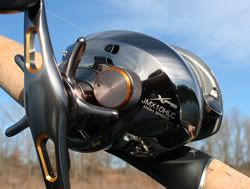 |
| The spool tension knob is the main coarse adjustment on your casting reel. |
Casting reels are equipped with braking systems that help manage the speed of the rotation of the spool during a cast in order to minimize backlashes. If you've never had one, a backlash (also dubbed "bird's nest" or "professional overrun") is the tangled, knotted mess of line that results when your spool continues to spin after your lure has stopped moving forward. Backlashes are the bane of angler's everywhere and probably the number one deterrent to those hesitant to add a casting combo to their gear arsenal.
The spool tension knob is the main coarse adjustment on your casting reel. This is the first thing you should adjust, and applying the correct amount of tension to the spool is your first step toward combating backlash. The spool tension knob should be set tight enough that, when you disengage the spool, the lure should fall slowly to the ground. When it hits the ground, the spool should not turn more than once. A spool tension knob is found on every casting reel.
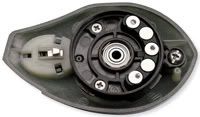 |
| Magnets in the side plate of a reel with a magnetic braking system. |
Magnetic brakes and centrifugal brakes are the two most common braking systems. Centrifugal braking systems are friction based and typically have pins that adjust to apply more or less friction to the spool. When making adjustments, push the pins inward to take them out of play and push them out to engage the brakes. When adjusting pins, the rule of thumb is to remove brakes opposite of one another. So, if you're removing two of the brakes in a six-pin system, you would push two pins in that are directly across from one another rather than two that are directly beside each other.
Magnetic braking systems are harder to explain than centrifugal systems as they rely on a spool made of aluminum (a non-magnetic metal) reacting to a set of magnets. "How does a non-magnetic metal react to magnets," you ask? Well, when the aluminum spool is rotating, the closeness of the aluminum to the magnets creates what's called an "eddy current," and this eddy current creates the braking effect on the spool. Spool speed affects current strength -- the faster the rotation of the spool, the stronger the eddy current -- as does the distance of the magnets to the spool, which is why magnetic systems are adjustable. What we anglers need to know, though, is that you move the magnets closer to the spool to increase spool tension and move them farther from the spool to decrease spool tension.
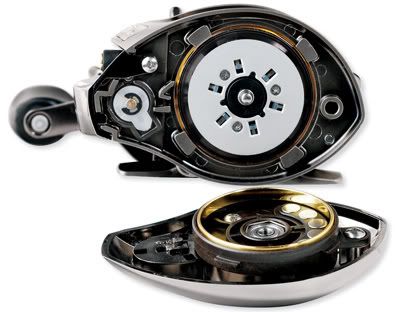 |
| Internals of a reel incorporating both magnetic and centrifugal brakes |
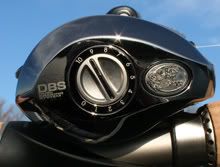 |
| Externally adjustable systems make on-the-water adjustments easy. |
Some braking systems, such as the Inertial Transfer Braking (ITB) system and Dual Braking System, make use of both friction and magnetic elements. What's especially nice about the ITB and Dual Braking Systems, though, is that they're both externally adjustable -- no popping off side plates to adjust pins or remove magnets while on the water.
On which system is better, actually it's a matter of personal preference. If you're going from a heavy lure to a lighter one, you have to make some adjustments. When you're fishing in windy conditions, you'll also need to adjust because the wind will slow the lure faster than the spool will slow from the initial cast. Making these on-the-water adjustments is where externally adjustable systems really come in handy. But for the most part, braking systems are fine tuning things. The heart of the matter is still practicing with your reel and learning to address the spool with your thumb.
Components & Materials
Once you've narrowed your options down to a few reels, the best way to determine which reel is the best choice for the amount of money you're ready to invest is by comparing the components of each reel. When comparing components, you want to look at the method of construction as well as the materials used for construction. Below we'll discuss the key casting reel components, material options and construction methods.
Frame
Casting reel frames are usually made of either graphite or aluminum. Graphite is lightweight and tends to be less expensive than aluminum. The drawback, however, is that graphite flexes under pressure. Aluminum frames, which tend to be found on more expensive casting reels, are more rigid. A rigid frame ensures all moving parts remain properly aligned. Top-of-the-line reels have one-piece aluminum frames.
Gears
Gears are extremely important -- probably the most important component to consider. The difference between a reel with good gears and one with inferior gears is usually noticeable immediately just by turning the handle. When you pick up a nice reel and turn the handle, you'll feel the smoothness and appreciate how easy it is to turn the handle.
Most main gears are brass with a steel pinion gear. Duralumin, which is extremely lightweight and strong, is used for gearing on the very finest reels. If the difference between a reel with good gears and another with mediocre gears is minimal, spend it if you can -- you won't regret it.
Ball Bearings

Many anglers believe that the more bearings a reel has, the better it is. That's not actually the case, though, as all bearings are not created equal. Shielded, double-shielded and sealed bearings are the highest quality and are usually made in Germany or Japan. The lowest-grade bearings are made of lower quality steel. Bearings made from low-quality steel will rust and won't wear as well as high-quality bearings.
If you get a 10-bearing reel for $150, you can almost bet it's packed with cheap bearings. So, if you're presented with a choice between a reel with 3 good bearings and a reel with 10 cheap bearings (assuming they're the same price and all other things are equal), opt for the reel with fewer, yet higher quality bearings.
Spools

Most all reels have aluminum spools. Where they differ, though, is in the construction process. The least expensive spools are die-cast. Spools machined from stock are more expensive, and top-of-the-line spools are forged.
Machined spools scratch fairly easy, while a forged spool is very hard to scratch. Forged spools are harder, denser and more rigid so that they don't flex under pressure. Drilled spools (those with holes through them) are lightweight, making them easier to start and stop spinning. Non-drilled spools are heavier and require more force to get going; once they start spinning, non-drilled spools take a little more pressure from the thumb to stop.
Drag systems

In general, drag systems are more critical for saltwater species and long-running fish than they are for bass. If you fish saltwater or target one of those freshwater species that like to run, make sure you find a drag that functions smoothly and that you know how to use it. (Note: Drag should be set at around 25% of the breaking strength of your line.)
Handle
While not as important as the reel's internals, handles can affect the comfort level of your reel and overall appearance. Forged handles are more expensive than stamped ones. Soft-touch knobs are more desirable than hard-plastic ones.
Line guide

Top-of-the-line reels usually have a line guide made of titanium. Ceramic line guides are less expensive but can crack or break if swivels are reeled through the guide.
If you're at a point in your angling career where you'd like to try new tactics and target new species but don't feel that your spinning tackle is up to the task, it's time to look at casting setups.
Follow the suggestions presented above while wading through the options and -- once you've narrowed your choices -- compare components. You're sure to get the best reel for your money that way. Just remember, no matter what reel you buy or how much you invest, educating your thumb through practice is the only way to become skillful and accurate with your new tool.
Tag :
Articles,
buy reel,
casting technique,
Fishing,
How to,
Introduction,
Reel,
Review,
Tips,
Tutorial



0 Comments for "A Guide Buying Casting Reels "